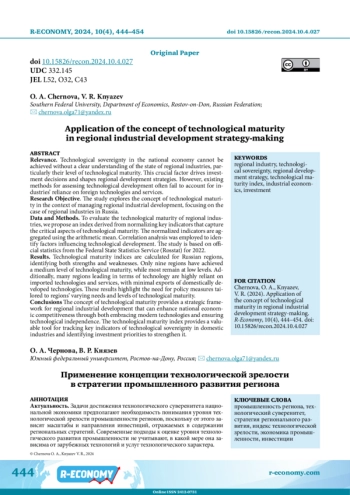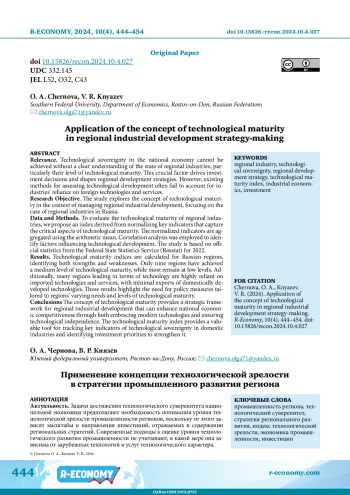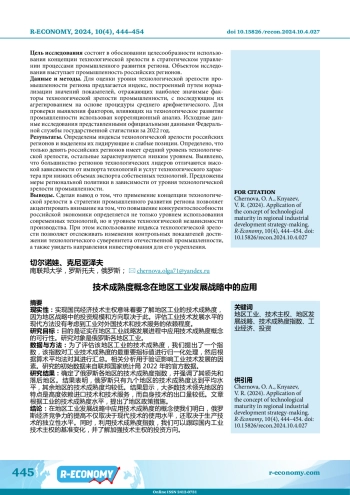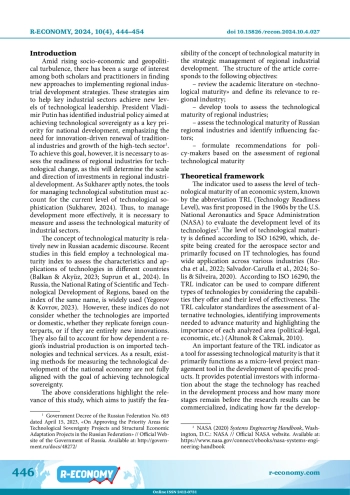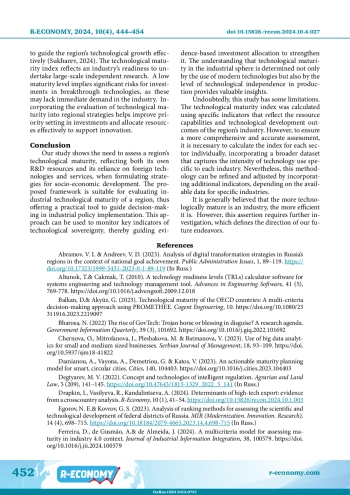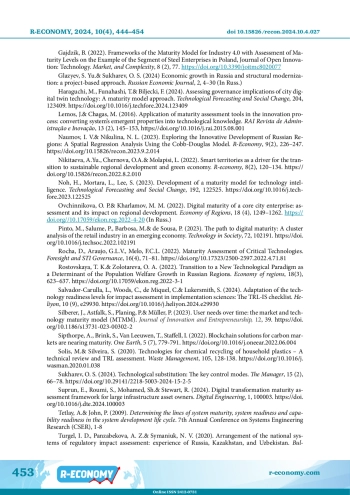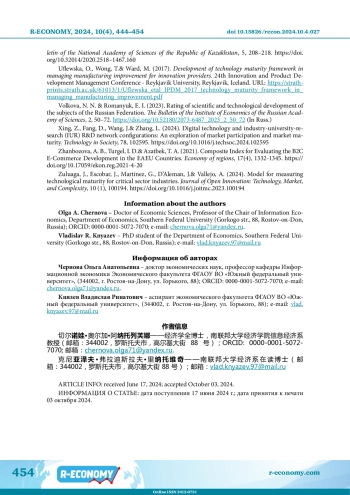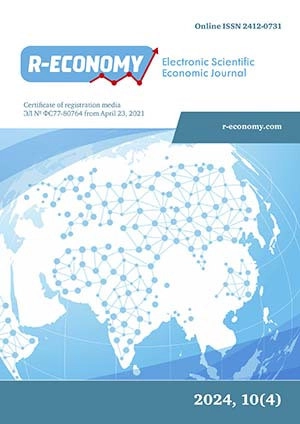Relevance. Technological sovereignty in the national economy cannot be achieved without a clear understanding of the state of regional industries, particularly their level of technological maturity. This crucial factor drives investment decisions and shapes regional development strategies. However, existing methods for assessing technological development often fail to account for industries’ reliance on foreign technologies and services. Research Objective. The study explores the concept of technological maturity in the context of managing regional industrial development, focusing on the case of regional industries in Russia. Data and Methods. To evaluate the technological maturity of regional industries, we propose an index derived from normalizing key indicators that capture the critical aspects of technological maturity. The normalized indicators are aggregated using the arithmetic mean. Correlation analysis was employed to identify factors influencing technological development. The study is based on official statistics from the Federal State Statistics Service (Rosstat) for 2022. Results. Technological maturity indices are calculated for Russian regions, identifying both strengths and weaknesses. Only nine regions have achieved a medium level of technological maturity, while most remain at low levels. Additionally, many regions leading in terms of technology are highly reliant on imported technologies and services, with minimal exports of domestically developed technologies. These results highlight the need for policy measures tailored to regions’ varying needs and levels of technological maturity. Conclusions The concept of technological maturity provides a strategic framework for regional industrial development that can enhance national economic competitiveness through both embracing modern technologies and ensuring technological independence. The technological maturity index provides a valuable tool for tracking key indicators of technological sovereignty in domestic industries and identifying investment priorities to strengthen it.
Идентификаторы и классификаторы
Amid rising socio-economic and geopolitical turbulence, there has been a surge of interest among both scholars and practitioners in finding new approaches to implementing regional industrial development strategies. These strategies aim to help key industrial sectors achieve new levels of technological leadership. President Vladimir Putin has identified industrial policy aimed at achieving technological sovereignty as a key priority for national development, emphasizing the need for innovation-driven renewal of traditional industries and growth of the high-tech sector1. To achieve this goal, however, it is necessary to assess the readiness of regional industries for technological change, as this will determine the scale and direction of investments in regional industrial development. As Sukharev aptly notes, the tools for managing technological substitution must account for the current level of technological sophistication (Sukharev, 2024). Thus, to manage development more effectively, it is necessary to measure and assess the technological maturity of industrial sectors.
Список литературы
1. Abramov V. I., Andreev V. D. (2023). Analysis of digital transformation strategies in Russia’s regions in the context of national goal achievement. Public Administration Issues, 1, 89-119. (In Russ.). DOI: 10.17323/1999-5431-2023-0-1-89-119 EDN: JOKUIR
2. Altunok T., Cakmak T. (2010). A technology readiness levels (TRLs) calculator software for systems engineering and technology management tool. Advances in Engineering Software, 41 (5), 769-778. DOI: 10.1016/j.advengsoft.2009.12.018
3. Balkan D., Akyüz G. (2023). Technological maturity of the OECD countries: A multi-criteria decision-making approach using PROMETHEE. Cogent Engineering, 10. DOI: 10.1080/23311916.2023.2219097
4. Bharosa N. (2022) The rise of GovTech: Trojan horse or blessing in disguise? A research agenda. Government Information Quarterly, 39 (3), 101692. DOI: 10.1016/j.giq.2022.101692 EDN: CWVZLR
5. Chernova O., Mitrofanova I., Pleshakova M., Batmanova V. (2023). Use of big data analytics for small and medium sized businesses. Serbian Journal of Management, 18, 93-109. DOI: 10.5937/sjm18-41822 EDN: PZVXZJ
6. Damianou A., Vayona A., Demetriou G., Katos V. (2023). An actionable maturity planning model for smart, circular cities. Cities, 140, 104403. DOI: 10.1016/j.cities.2023.104403 EDN: DAYFEB
7. Degtyarev M. V. (2022). Concept and technologies of intelligent regulation. Agrarian and Land Law, 5 (209), 141-145. (In Russ.). DOI: 10.47643/1815-1329_2022_5_141 EDN: AHOAQU
8. Drapkin I., Vasilyeva R., Kandalintseva A. (2024). Determinants of high-tech export: evidence from a crosscountry analysis. R-Economy, 10 (1), 41-54. DOI: 10.15826/recon.2024.10.1.003 EDN: GOQWKR
9. Egorov N. E., Kovrov G. S. (2023). Analysis of ranking methods for assessing the scientific and technological development of federal districts of Russia. MIR (Modernization. Innovation. Research), 14 (4), 698-715. (In Russ.). DOI: 10.18184/2079-4665.2023.14.4.698-715 EDN: FURQME
10. Ferreira D., de Gusmão A., de Almeida J. (2024). A multicriteria model for assessing maturity in industry 4.0 context. Journal of Industrial Information Integration, 38, 100579. DOI: 10.1016/j.jii.2024.100579 EDN: YHRTCR
11. Gajdzik B. (2022). Frameworks of the Maturity Model for Industry 4.0 with Assessment of Maturity Levels on the Example of the Segment of Steel Enterprises in Poland, Journal of Open Innovation: Technology. Market, and Complexity, 8 (2), 77. DOI: 10.3390/joitmc8020077 EDN: KCMSZB
12. Glazyev S. Yu., Sukharev O. S. (2024) Economic growth in Russia and structural modernization: a project-based approach //Russian Economic Journal, 2, 4-30 (In Russ.). EDN: YETAOG
13. Haraguchi M., Funahashi T., Biljecki F. (2024). Assessing governance implications of city digital twin technology: A maturity model approach. Technological Forecasting and Social Change, 204, 123409. DOI: 10.1016/j.techfore.2024.123409 EDN: NSERBM
14. Lemos J., Chagas M. (2016). Application of maturity assessment tools in the innovation process: converting system’s emergent properties into technological knowledge. RAI Revista de Administração e Inovação, 13 (2), 145-153,. DOI: 10.1016/j.rai.2015.08.001
15. Naumov I. V., Nikulina N. L. (2023). Exploring the Innovative Development of Russian Regions: A Spatial Regression Analysis Using the Cobb-Douglas Model. R-Economy, 9(2), 226-247. DOI: 10.15826/recon.2023.9.2.014 EDN: CRXHVG
16. Nikitaeva A. Yu., Chernova O. A., Molapisi L. (2022). Smart territories as a driver for the transition to sustainable regional development and green economy. R-economy, 8(2), 120-134. DOI: 10.15826/recon.2022.8.2.010 EDN: GICODJ
17. Noh H., Mortara L., Lee S. (2023). Development of a maturity model for technology intelligence. Technological Forecasting and Social Change, 192, 122525. DOI: 10.1016/j.techfore.2023.122525 EDN: ROOSHF
18. Ovchinnikova O. P., Kharlamov M. M. (2022). Digital maturity of a core city enterprise: assessment and its impact on regional development. Economy of Regions, 18 (4), 1249-1262. /10.17059/ekon.reg.2022-4-20 (In Russ.). DOI: 10.17059/ekon.reg.2022-4-20(InRuss.) EDN: EHQOUF
19. Pinto M., Salume P., Barbosa M., de Sousa P. (2023). The path to digital maturity: A cluster analysis of the retail industry in an emerging economy. Technology in Society, 72, 102191. DOI: 10.1016/j.techsoc.2022.102191 EDN: UDYXUW
20. Rocha D., Araujo G. L. V., Melo F. C. L. (2022). Maturity Assessment of Critical Technologies. Foresight and STI Governance, 16(4), 71-81. DOI: 10.17323/2500-2597.2022.4.71.81 EDN: XUTGBB
21. Rostovskaya T. K., Zolotareva O. A. (2022). Transition to a New Technological Paradigm as a Determinant of the Population Welfare Growth in Russian Regions. Economy of regions, 18(3), 623-637. DOI: 10.17059/ekon.reg.2022-3-1 EDN: VTNIJV
22. Salvador-Carulla L., Woods C., de Miquel C., Lukersmith S. (2024). Adaptation of the technology readiness levels for impact assessment in implementation sciences: The TRL-IS checklist. Heliyon, 10 (9), e29930. DOI: 10.1016/j.heliyon.2024.e29930 EDN: ZBSBAM
23. Silberer J., Astfalk S., Planing, P., Müller P. (2023). User needs over time: the market and technology maturity model (MTMM). Journal of Innovation and Entrepreneurship, 12, 39. DOI: 10.1186/s13731-023-00302-2 EDN: NDJLTX
24. Sipthorpe A., Brink S., Van Leeuwen T., Staffell I. (2022). Blockchain solutions for carbon markets are nearing maturity. One Earth, 5 (7), 779-791. DOI: 10.1016/j.oneear.2022.06.004 EDN: DPWCWG
25. Solis M., Silveira S. (2020). Technologies for chemical recycling of household plastics - A technical review and TRL assessment. Waste Management, 105, 128-138. DOI: 10.1016/j.wasman.2020.01.038 EDN: EIYLVF
26. Sukharev O. S. (2024). Technological substitution: The key control modes. The Manager, 15 (2), 66-78. DOI: 10.29141/2218-5003-2024-15-2-5 EDN: MDMCNU
27. Suprun E., Roumi S., Mohamed Sh., Stewart R. (2024). Digital transformation maturity assessment framework for large infrastructure asset owners. Digital Engineering, 1, 100003. DOI: 10.1016/j.dte.2024.100003 EDN: RCBRLR
28. Tetlay A., John P. (2009). Determining the lines of system maturity, system readiness and capability readiness in the system development life cycle. 7th Annual Conference on Systems Engineering Research (CSER), 1-8.
29. Turgel I. D., Panzabekova A. Z., Symaniuk N. V. (2020). Arrangement of the national systems of regulatory impact assessment: experience of Russia, Kazakhstan, and Uzbekistan. Bulletin of the National Academy of Sciences of the Republic of Kazakhstan, 5, 208-218. DOI: 10.32014/2020.2518-1467.160 EDN: PUWQWC
30. Uflewska O., Wong T., Ward M. (2017). Development of technology maturity framework in managing manufacturing improvement for innovation providers. 24th Innovation and Product Development Management Conference - Reykjavik University, Reykjavik, Iceland. URL: https://strathprints.strath.ac.uk/61013/1/Uflewska_etal_IPDM_2017_technology_maturity_framework_in_managing_manufacturing_improvement.pdf.
31. Volkova N. N., Romanyuk E. I. (2023). Rating of scientific and technological development of the subjects of the Russian Federation. The Bulletin of the Institute of Economics of the Russian Academy of Sciences, 2, 50-72. (In Russ.). DOI: 10.52180/2073-6487_2023_2_50_72 EDN: QBNXNT
32. Xing Z., Fang D., Wang J., Zhang L. (2024). Digital technology and industry-university-research (IUR) R&D network configurations: An exploration of market participation and market maturity. Technology in Society, 78, 102595. DOI: 10.1016/j.techsoc.2024.102595 EDN: RTKOEQ
33. Zhanbozova A. B., Turgel I. D., Azatbek T. A. (2021). Composite Index for Evaluating the B2C E-Commerce Development in the EAEU Countries. Economy of regions, 17(4), 1332-1345. DOI: 10.17059/ekon.reg.2021-4-20 EDN: QJZANL
34. Zuluaga J., Escobar J., Martínez G., D’Aleman J., Vallejo A. (2024). Model for measuring technological maturity for critical sector industries. Journal of Open Innovation: Technology, Market, and Complexity, 10 (1), 100194. DOI: 10.1016/j.joitmc.2023.100194 EDN: IXAWVS
Выпуск
Другие статьи выпуска
Relevance The growing importance of creative industries in Russia’s economy underscores the need for effective management strategies to support the reindustrialization of second-tier cities, with a focus on socio-economic growth and the preservation of local identity. Research Objective The article aims to identify key factors that influence the development and implementation of creative reindustrialization strategies in second-tier cities. Data and Methods Using econometric modeling, the study analyzed data from 50 industrial cities in Sverdlovsk and Chelyabinsk regions (2010-2024), sourced from the Federal State Statistics Service, the Ministry of Construction, Housing and Utilities, and the Presidential Grant Foundation. Results. The study identified key factors contributing to the growth of creative industries, including the expansion of creative sector companies, proximity to regional centers, increased grant applications, the presence of manufacturing enterprises, growth in local government revenue, and the development of new housing. A comprehensive set of government support measures was proposed, encompassing infrastructure development, financial assistance, educational initiatives, informational resources, and regulatory improvements. Conclusions Essential government support to creative industries should include infrastructure development, simplified administrative procedures, tax incentives, institutional and legislative backing, and export promotion. Other support measures can be tailored to the chosen management strategy and regional needs, resulting in the creation of a flexible system centered around local identity.
Relevance. Corruption remains a persistent issue in many countries, including Kazakhstan. By exploring the relationship between the socio-economic characteristics of specific regions and corruption, this research can provide a foundation for informed policy-making and targeted anti-corruption efforts and thus help mitigate its negative impact on regional development. Research Objective. The research aims to assess the impact of corruption on regional socio-economic development in Kazakhstan through the creation and application of a multifactor corruption index. Data and Methods. The study uses official statistical data on corruption offenses and regional socio-economic indicators, including industrial production, fixed asset investments, household expenditures, unemployment rates, and foreign trade volumes. A multifactor index methodology was employed, using Pearson correlation coefficients to calculate averaged absolute values of sub-indices for each indicator. Results. The study found strong correlations between corruption and socio-economic indicators in regions like East Kazakhstan, Abay, Akmola, and Kostanay. The economic structure of these regions plays a key role: East Kazakhstan and Akmola, with dominant mining industries, are more vulnerable to corruption due to public contracts and licensing. Kostanay’s agricultural sector, central to its economy, is prone to corruption in land allocation, subsidies, and procurement. The economic importance of these sectors amplifies the impact of corruption on development, strengthening the correlation. Conversely, regions with lower index values show weaker correlations in the analysis, likely due to economic diversity, incomplete data, or less effective governance mechanisms. Conclusions. The regional specificity of the interrelation between corruption and socio-economic development in Kazakhstan necessitates tailored approaches that consider the unique conditions of each region. These findings can be of interest to policymakers and other stakeholders. The proposed methodology allows for a more precise assessment of both hidden and visible corruption risks, highlighting critical areas for implementing effective anti-corruption measures.
Relevance. Russia is currently facing sanctions, which have had significant economic and social consequences. These crises have revealed vulnerabilities in the socio-economic system, highlighting the importance of studying them to better address current challenges and mitigate future risks. Objective. The study aims to identify the vulnerabilities in particular aspects of sustainable development across Russia’s regions during the crises of the past 15 years. Data and methods. The study draws on data from the Federal Statistical Service (Rosstat) to calculate a sustainable development index for regions, which tracks the impact of crises on their economic, social, and environmental sustainability. The index is constructed using a classical method, comprising three averaged sub-indices, each representing one of the three components of sustainable development. A higher index value indicates greater sustainability, with the impact of crises varying across regions. Results. During the 2014 crisis, regions specializing in export-oriented industries or those with a significant share of foreign capital in their economies were hit the hardest. Socially, the most vulnerable regions were those along the Chinese border in the Far East, which were impacted by trade restrictions. The 2020 pandemic had economic effects on nearly all regions, with cities of over a million people and their agglomerations suffering the most due to the abrupt suspension of the tertiary sector. The social sphere responds most quickly to crises, while the environmental component is more inert but shows a negative trend despite the crises. Conclusions. For regions with underdeveloped and monocentric economies, support measures should focus on diversifying industries, particularly those aimed at mass consumption. In coal-mining regions, it’s important to develop service sectors related to the industry during stable periods. For the Far Eastern regions, the main support measure is to stimulate industries geared towards meeting Chinese demand.
Relevance. Inter-municipal cooperation is an effective tool for addressing resource deficits faced by municipalities, and its importance has grown in today’s context of socio-economic instability. However, the success of such cooperation largely depends on a careful selection of partners, which raises the question of how the strength of ties between municipalities impacts their ability to collaborate effectively. Research objective. The aim of this study is to explore how the spatial characteristics of interdependence between municipalities influence their interactions and cooperation. Data and methods. The research draws on official statistical data from Russia’s Federal State Statistics Service (Rosstat), as well as information from investment passports and municipal socio-economic development strategies. The study employs spatial correlation methods, cartographic analysis, and general research techniques, including analysis and synthesis. Results. The inter-municipal relationships in Sverdlovsk Region are highly uneven, with significant disparities in the level of involvement across different areas. These relationships are predominantly concentrated around the region’s administrative center and its neighboring municipalities, while the northern and eastern parts exhibit the weakest connectivity. Municipalities in the Ekaterinburg urban agglomeration are the most active participants in joint projects, whereas those in the southwestern part of the region show less involvement. The northern and eastern areas, in particular, demonstrate minimal engagement in forming partnerships with other municipalities, highlighting a stark regional imbalance. Conclusions. The study confirms a strong link between the interdependence of municipalities and the extent of their cooperation. Factors such as territorial and socio-economic proximity play a key role, but additional drivers, such as national or regional policies, also significantly influence inter-municipal collaboration. Interestingly, a lack of resources among potential partners does not appear to impede cooperation.
Relevance. The well-being of citizens is a key focus of national policies worldwide. Kazakhstan, however, is characterized by significant regional disparities in social well-being, which necessitates targeted programs and investments to improve conditions in less developed areas. Research Objective. This study aims to develop a national adaptive social well-being index to evaluate and spatially map the regions of Kazakhstan. Data and Methods. The methodology included identifying indicators through a literature review and regional data, conducting an expert survey to weight them, and creating a social well-being index. A spatial analysis was then used to calculate the index for each region. Results. The social well-being index shows significant disparities across regions. Astana, Almaty, and Atyrau demonstrate strong social welfare, driven by economic growth and advanced social infrastructure. In contrast, Karaganda, Pavlodar, and Shymkent show lower social welfare, highlighting the need for targeted interventions and investments. Conclusion. The findings offer valuable insights for policymakers to design strategies for sustainable socioeconomic growth in Kazakhstan. The proposed index can help national and regional authorities monitor social well-being.
Relevance. The global imperative for adopting a low-carbon economy resonates worldwide, yet comprehensive assessments specific to the Russian economy remain scant. This is especially important considering the significant differences in the level of transition to sustainable development among Russian regions. Research Objective. This study aims to introduce a robust methodology for evaluating and analyzing the international trade of low-carbon goods (LCGs) across various Russian regions and assessing its effects on fuel combustion emissions. Data and Methods. Data on LCGs trade were obtained from the Federal Customs Service of Russia. In conjunction, datasets from Rosstat and the Central Bank of Russia were incorporated for comprehensive econometric modeling. The analytical framework employed Tobit and quantile regressions. Results. The study uncovers significant disparities among Russian regions regarding the intensity of low-carbon goods exports and imports. This variation highlights the diverse competencies in LCGs production, as well as differing ecological agendas and consumption patterns across regions. Additionally, the research demonstrates that, although the widespread adoption of advanced production technologies is positively correlated with increased fuel combustion emissions, a U-shaped relationship exists where higher LCGs exports are associated with reductions in fuel combustion emissions across Russian regions to a certain degree. Conclusions. This research highlights important implications for both federal and regional industrial and environmental policies. It advocates for the development of targeted incentives that encourage the adoption of low-carbon goods (LCGs) and advanced technologies. By doing so, policymakers can effectively promote sustainable development tailored to the unique needs and conditions of various regions, thereby fostering ecological resilience and economic growth across diverse regional landscapes.
Статистика статьи
Статистика просмотров за 2025 год.
Издательство
- Издательство
- УрФУ
- Регион
- Россия, Екатеринбург
- Почтовый адрес
- 620002, Свердловская область, г. Екатеринбург, ул. Мира, д. 19
- Юр. адрес
- 620002, Свердловская область, г. Екатеринбург, ул. Мира, д. 19
- ФИО
- Кокшаров Виктор Анатольевич (Ректор)
- E-mail адрес
- rector@urfu.ru
- Контактный телефон
- +7 (343) 3754507
- Сайт
- https://urfu.ru/ru
